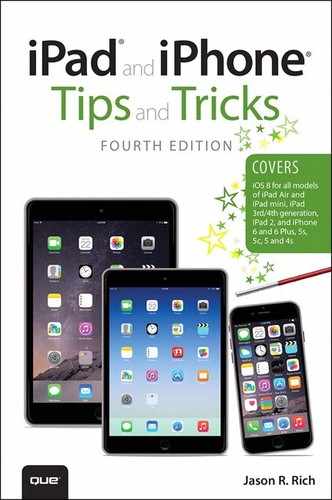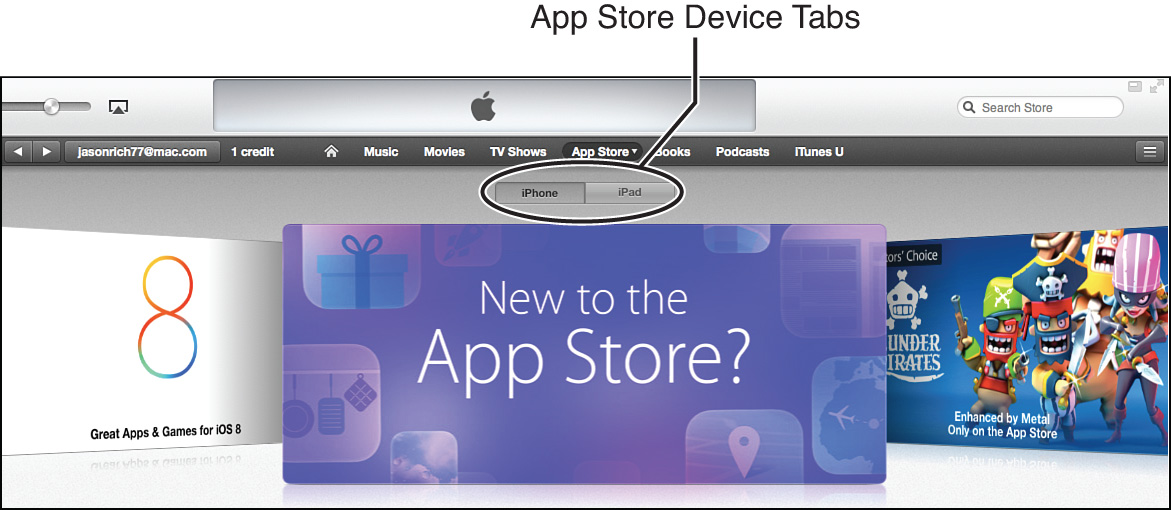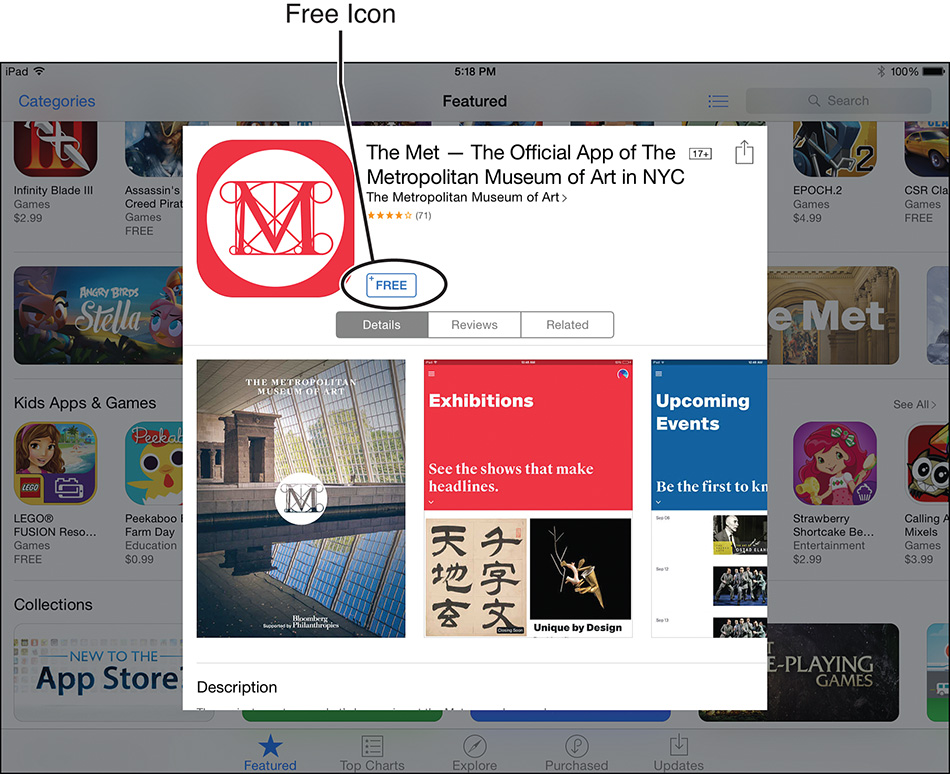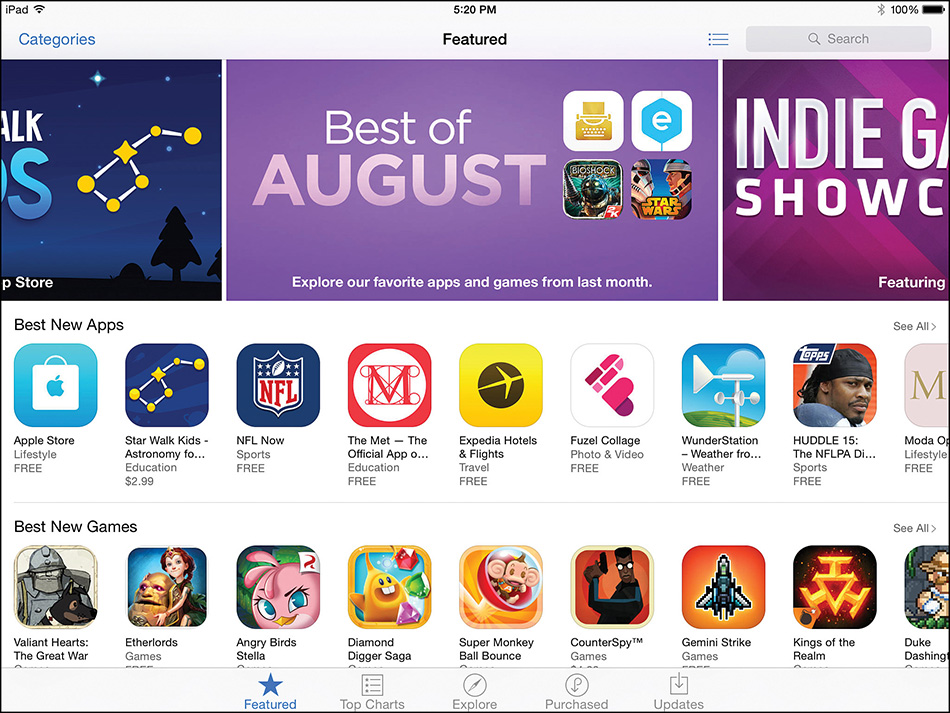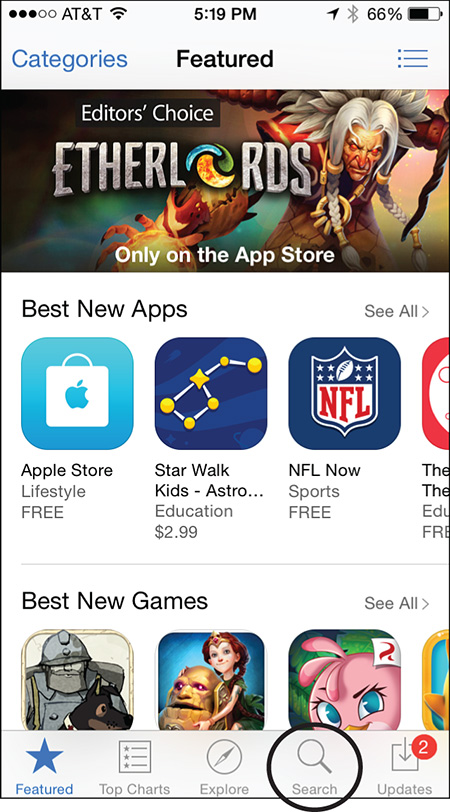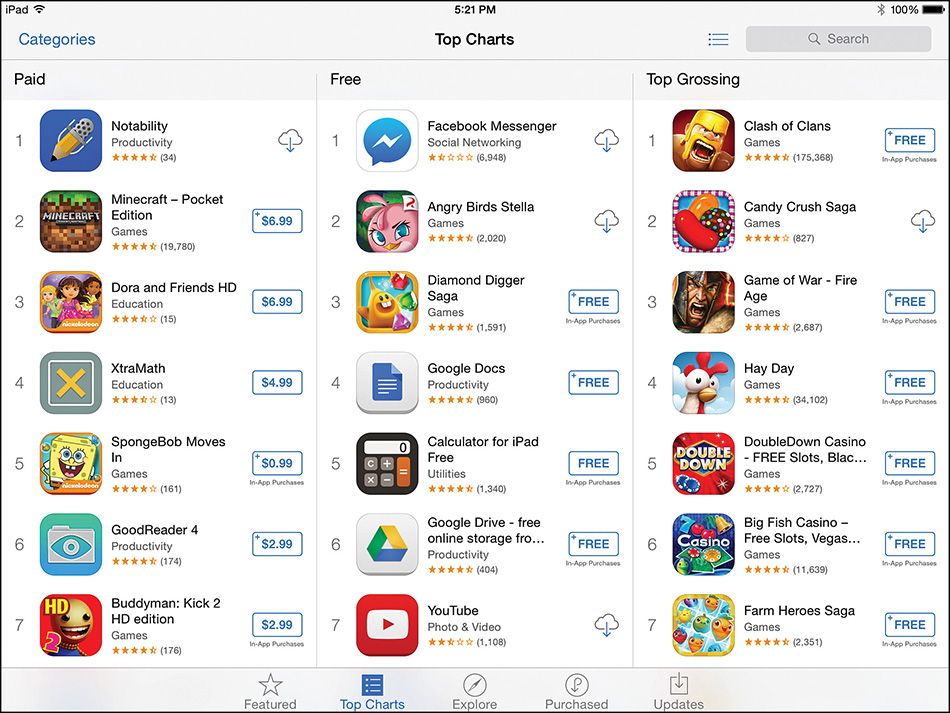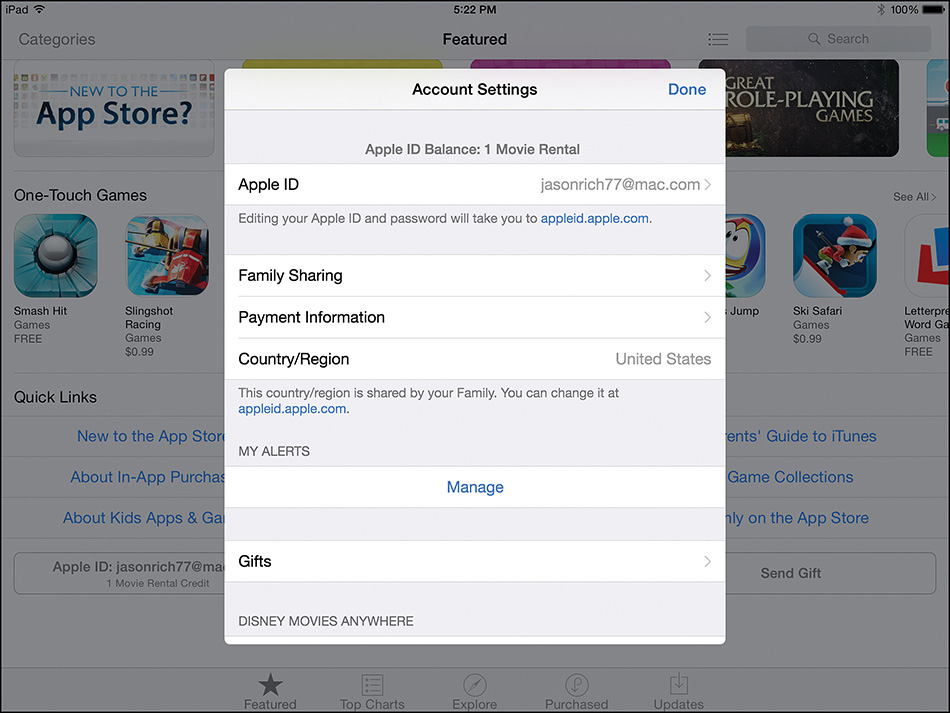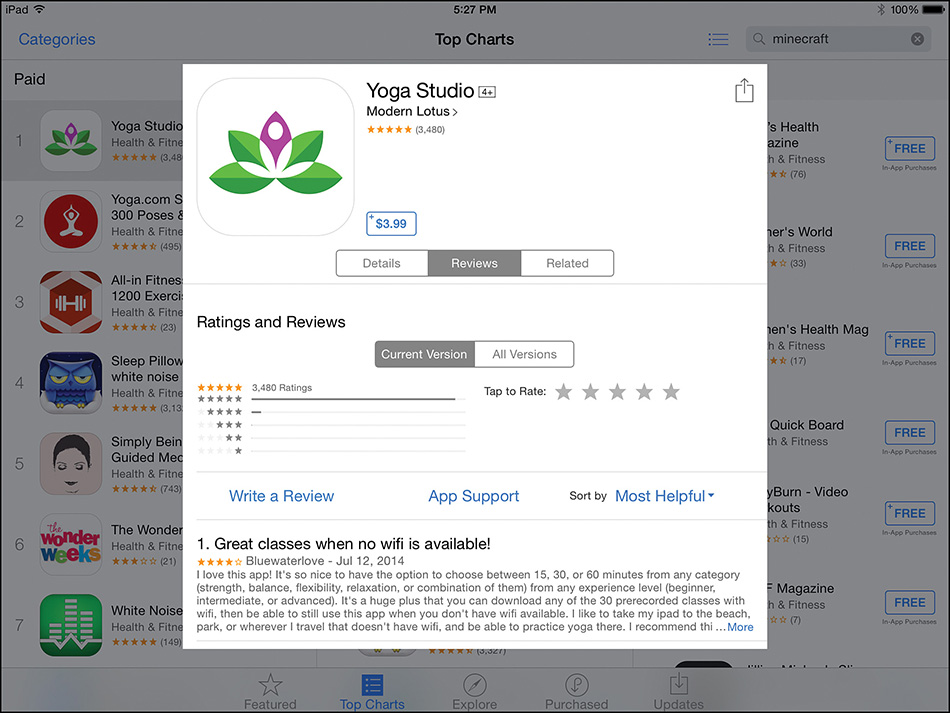3. Strategies for Finding, Buying, and Using Third-Party Apps
In This Chapter
![]() Install optional apps onto your iOS mobile device from the App Store
Install optional apps onto your iOS mobile device from the App Store
![]() Pinpoint the apps that are of interest to you or relevant to your needs
Pinpoint the apps that are of interest to you or relevant to your needs
![]() Learn the difference between iPhone-specific, iPad-specific, and hybrid apps
Learn the difference between iPhone-specific, iPad-specific, and hybrid apps
The collection of preinstalled apps that comes with iOS 8 enables you to begin utilizing your iPhone or iPad for a wide range of popular tasks without first having to find and install additional apps. However, one of the things that has set the iPhone and iPad apart from its competition and made these devices among the most sought-after and popular throughout much of the world is the vast library of optional apps available for them.
Whereas other smartphones or tablets might offer a collection of a few hundred or even a few thousand optional apps, third-party developers have created an ever-growing collection of iPhone and iPad apps that’s now in excess of 1.3 million. An additional selection of optional apps is or will soon be available for the Apple Watch.
All the apps currently available for your iOS device can be obtained from Apple’s online-based App Store. Then, as needed, iOS 8 can automatically update your apps to ensure you’re always working with the most recently released version.
Although some apps are tweaked to work exceptionally well on the latest iPhone or iPad models, such as the iPhone 6 Plus, all iPhone-specific apps can scale themselves automatically to accommodate the iPhone model you’re using, whether it has a 4", 4.7", or 5.5" display. Likewise, apps for the iPad (as well as hybrid iPhone/iPad apps) automatically adapt to the screen size of the device you’re using.
![]() Tip
Tip
From the App Store, several Apple-created (or endorsed) iPhone and iPad apps are available. Some of these free apps include Find My Friends (for tracking the whereabouts of your friends and family and allowing them to track your location in real time), iTunes U (for accessing the incredible collection of personal enrichment and educational content compiled by Apple), the official Twitter app, the official Facebook app, and Find My iPhone.
App Store Basics
There are two ways to access the App Store: directly from your iPhone or iPad (using the App Store app that comes preinstalled on your device) or using the iTunes software on your primary computer.
The App Store app is used exclusively for finding, purchasing (if applicable), downloading, and installing apps directly onto your device from the App Store. Other apps are used to access additional types of content. iTunes on your primary computer is used to access the App Store as well as many other types of content.
How New Apps Install Themselves
If you’re shopping for apps directly from your iPhone or iPad, tap on the Price icon, followed by the Buy icon, to make a purchase. You might be asked to supply your Apple ID password to confirm the transaction. The app automatically downloads and installs itself on your device. After it is installed, its app icon appears on your iPhone or iPad’s Home screen and is ready to use.
You can also shop for apps from your primary computer and transfer them to your iPhone or iPad, or sync apps between your various mobile devices using the iTunes Sync process or iCloud.
Instead of manually entering your Apple ID password to confirm an app purchase (or acquire a free app), if your iOS mobile device is equipped with a Touch ID sensor as part of its Home button, you can simply scan your fingerprint to approve the transaction. For this to work, the feature must be turned on once from within Settings. To do this, launch Settings, tap on the Touch ID & Passcode option, and then turn on the virtual switch that’s associated with the iTunes & App Store option.
Free or Purchased?
Some apps available from the App Store are free. To download them, you go through the same process as you do for purchasing an app; however, instead of tapping on the Price icon, followed by the Buy icon, you must tap on the Free icon associated with the app, followed by the Install icon. You are not charged for downloading a free app. You do, however, still need to supply your Apple ID password to confirm the transaction.
In addition to apps, you can add a wide range of content to your iPhone or iPad, such as music, movies, TV shows, podcasts, audiobooks, and eBooks. How to acquire and enjoy this content is mentioned later in this chapter.
Restoring or Reinstalling Apps You’ve Already Downloaded
If you have Family Sharing set up via iCloud (see Chapter 5, “Ways to Use iCloud’s Latest Features with Your iPhone and/or iPad”), you can share apps you acquire with up to five other family members without having to repurchase that app. With or without Family Sharing, you can also install the app on all of your own iOS mobile devices that are linked to the same iCloud account, as long as the app is compatible with each device.
To download an app onto your iPad that has already been purchased or downloaded onto another computer or device, tap on the Purchased icon that’s displayed at the bottom of the screen in the App Store app. On the iPhone, tap on the Updates icon, and then tap on the Purchased option that’s displayed near the top of the Updates screen. All your app purchases to date are displayed.
As an app is downloading from the App Store to your mobile device, to pause the process, tap on the Download icon that’s displayed in the app description or app preview box in the App Store, or tap on the app icon as it’s installing on the Home screen. To resume the download and installation process, tap the icon again.
![]() Note
Note
At the top of the Purchased screen on the iPhone or iPad, tap on the All tab to view all of the apps you’ve purchase to date for that device. You also have the option to tap on the Not On This iPhone/Not On This iPad tab to view apps you’ve acquired in the past but that are not currently installed on the device you’re using.
Instead of a Free or Price icon being associated with each app description, an iCloud icon indicates the app is available through your iCloud account. Tap on the iCloud icon to download the app (without having to pay for it again) to the iOS device you’re currently using. You can only install already purchased apps that are compatible with that iOS device. For example, you can’t install an iPad-specific app onto an iPhone or iPod touch. You can, however, install iPhone-specific or hybrid apps onto an iPad or iPad mini.
![]() Tip
Tip
From the Settings app, you have the option of having your iOS device automatically download and install any new (and compatible) apps, music, or eBooks purchased using your Apple ID on any other computer or device. To set this up, launch Settings, select the iTunes & App Store option from the main Settings menu, and then adjust the Automatic Downloads options, which include Music, Apps, and Books. You also can decide whether this feature works with a cellular data Internet connection or just when a Wi-Fi connection is available.
Where to Find Apps, Music, and More
If you’re shopping for apps, music, movies, TV shows, podcasts, audiobooks, eBooks, ringtones, or other content from your primary computer, with the goal of transferring what you acquire to your iPhone or iPad later via the iTunes sync process or via iCloud, use the latest version of the iTunes software on your Mac or PC computer.
However, from your iPhone or iPad, acquiring and then enjoying different types of content is done using a handful of different apps. Table 3.1 explains which app you should use to acquire and then enjoy various types of content on your iOS device.
Everything You Need to Know About Apps
Apps are individual programs that you install on your iPhone or iPad to give it additional functionality, just as you utilize different programs on your primary computer. For the iPhone or iPad, all apps are available from one central (online-based) location, called the App Store.
When you begin exploring the App Store, you’ll discover right away that there are in excess of 1.3 million apps to choose from. They are divided into different categories to help make it easier and faster to find what you’re looking for.
The App Store’s app categories include Games, Kids, Newsstand, Books, Business, Catalogs, Education, Entertainment, Finance, Food & Drink, Health & Fitness, Lifestyle, Medical, Music, Navigation, News, Photo & Video, Productivity, Reference, Social networking, Sport, Travel, Utilities, and Weather.
Compatibility: Does the App Run on Multiple Devices?
In terms of compatibility, all iOS apps fall into one of these three categories:
1. iPhone-specific—These are apps designed exclusively for the various iPhone models that might not function properly on the iPad. Most iPhone-specific apps will run on an iPad but will not take advantage of the tablet’s larger screen. Some iPhone-specific apps have been optimized to work with the larger screen of the iPhone 5s, iPhone 6, and/or iPhone 6 Plus.
2. iPad-specific—These are apps designed exclusively for the iPad. They fully utilize the tablet’s larger display and do not function on the iPhone or on other iOS devices. All iPad-specific apps do, however, function flawlessly on all iPad and iPad mini models.
3. Hybrid—Although you might encounter a few exceptions, these are apps designed to work on all iOS devices, including the iPhone and iPad. These apps detect which device they’re running on and adapt.
![]() Tip
Tip
When reading the App Store description of any app, tap on the Details tab and scroll down to the Information heading. Here, you can see a listing of which iOS devices the app is compatible with. Look for the Compatibility listing that’s found under the Information heading (see Figure 3.1).
FIGURE 3.1 From an app’s Description screen, you can see which iOS mobile devices the app is compatible with. Look for the Compatibility heading.
![]() Tip
Tip
If you own two or more iOS devices, such as an iPhone and an iPad (or an iPod touch), and all the devices are linked to the same Apple ID (iCloud) account, you can purchase a hybrid (or iPhone-specific) app once but install it on all of your iOS devices. This can be done through iTunes Sync or via iCloud after an app is initially purchased or downloaded.
When you’re browsing the App Store from your iPhone, by default it displays all iPhone-specific apps followed by hybrid apps, but it does not display iPad apps. When you’re browsing the App Store from your iPad, iPad-specific, hybrid, and iPhone-specific apps are all listed. Tap on the Phone or iPad tab that’s displayed near the top center of the screen when viewing many areas of the App Store.
If you’re shopping for apps using the iTunes software on your primary computer, click the iPhone or iPad tab that’s displayed near the top center of the iTunes screen (shown in Figure 3.2) to select which format apps you’re looking for.
FIGURE 3.2 When shopping for apps using iTunes on your primary computer (in this case, an iMac), click the appropriate tab to indicate which format apps you’re looking for, keeping in mind that iPhone-specific apps will run on an iPad (but not take advantage of the tablet’s larger screen), but iPad-specific apps do not run on an iPhone.
![]() Tip
Tip
Because some app developers release the same app in both an iPhone-specific and an iPad-specific format, many iPad-specific apps have “HD” for High-Definition in their title, to help differentiate them from iPhone or hybrid apps. Some iPad-specific apps include the words “for iPad” in their title.
Quick Guide to App Pricing
Regardless of whether you use the App Store app from your device or visit the App Store using the iTunes software on your primary computer, you must set up an Apple ID account and have a major credit card or debit card linked to the account to make purchases.
![]() Tip
Tip
If you don’t have a major credit card or debit card that you want to link with your Apple ID account, you can purchase prepaid iTunes Gift Cards from Apple or most places that sell prepaid gift cards.
iTunes Gift Cards are available in a variety of denominations and can be used to make app and other content purchases. They are distinct from Apple Gift Cards, which are only redeemable at Apple Stores or Apple.com.
The first time you access the App Store and attempt to make a purchase, you are prompted to enter your Apple ID account username and password or set up a new Apple ID account, which requires you to supply your name, address, email, and credit card information. For all subsequent online app purchases, you simply need to enter your Apple ID password, and the purchase is automatically billed to your credit or debit card or deducted from your iTunes Gift Card balance.
![]() Tip
Tip
An Apple ID account can also be referred to as an iTunes Store account. To learn more about how an Apple ID account works or to manage your account, visit www.apple.com/support/appleid. The same Apple ID you use to make purchases can also be used as your username when you’re using FaceTime for video calling, Messages to access the iMessage service, or to access your iCloud account.
Originally, when the App Store opened, there were two types of apps: free apps and paid apps. The free apps were often demo versions of paid apps (with limited functionality) or fully functional apps that displayed ads in the app. Paid apps were typically priced between $.99 and $9.99.
As the App Store has evolved, additional payment options and fee structures for apps have been introduced, giving app developers new ways to generate revenue and iPhone and iPad users different methods of paying for apps and content.
The following sections summarize the different types of apps from a pricing standpoint.
Free Apps
Free apps cost nothing to download and install on your phone or tablet. Some programmers and developers release apps for free out of pure kindness to share their creations with the iPhone- and/or iPad-using public. These are fully functional apps.
There are also free apps that serve as demo versions of paid apps. In some cases, certain features or functions of the app are locked in the free version, but are later made available if you upgrade to the paid or premium version of the app.
A third category of free apps comprises fully functional apps that display ads as part of their content. In exchange for using the app, you must view ads. These ads typically offer the option to click on special offers from within the app or learn more about a product or service being advertised.
A fourth category of free apps serves as a shell for premium (paid) content that must be loaded into the app to make it fully functional. For example, many newspaper and magazine publishers offer free apps related to their specific publications but require users to pay for the actual content of the newspaper or magazine, which later gets downloaded into the app.
The final type of free app enables the user to make in-app purchases to add features or functionality to the app or unlock premium content. The core app, without the extra content, is free, however.
![]() Tip
Tip
Some fully functional apps are free because they’re designed to promote a specific company or work with a specific service. For example, to use the free HBOGo app, you must be a paid subscriber of the HBO premium cable channel through your cable TV or satellite provider.
Likewise, to use the free Netflix app, you must be a paid subscriber to this streaming movie service. The AmEx app is useful only to people with an American Express Card, but the free Target app is useful to anyone who shops at Target stores.
When you’re looking at an app listing or description in the App Store, if the app is free, it has a Free icon instead of a Price icon, associated with it (as shown in Figure 3.3). Read a free app’s description carefully. Look for the heading In-App Purchases. This indicates that optional in-app purchases are available, and in some cases, these purchases are required to fully use the app.
Paid Apps
After you purchase an app, you own it and can use it as often as you’d like, usually without incurring additional fees (although in-app purchases might be possible). You simply pay a fee for the app upfront, which is often between $.99 and $9.99. Typically, future upgrades of the app are free of charge.
Subscription-Based Apps
Digital editions of magazines and newspapers can be purchased from the Newsstand app that comes preinstalled on your device. These publications each require their own proprietary app (also available from the App Store) to access and read the publication’s content. Digital editions of many popular publications are available from the Newsstand app.
These apps are typically free, and then you pay a recurring subscription fee for content, which automatically gets downloaded into the app. Many digital editions of newspapers, such as the New York Times and the Wall Street Journal, utilize a subscription app model, as do hundreds of different magazines.
Typically, the main content of the digital and printed version of a publication are identical. However, you can view the digital edition on your iPhone or iPad and take advantage of added interactive elements built in to the app. If you’re already a subscriber to the print version of a newspaper or magazine, some publishers offer the digital edition free, while others charge an extra fee to subscribe to the digital edition as well. Or you can subscribe to just the digital edition of a publication.
With some magazines, you can download the free app for a specific publication and then, in the app, purchase one issue at a time, including past issues. There is no long-term subscription commitment, but individual issues of the publication still must be purchased and downloaded. Or you can purchase an ongoing (recurring) subscription and new issues of that publication will automatically be downloaded to your iPhone or iPad as they become available.
![]() What’s New
What’s New
To utilize all of the features and functions built in to the Microsoft Word, Excel, PowerPoint, and OWA for iPad apps, a paid monthly subscription to Microsoft’s Office 365 service is required. You also must set up a free Microsoft OneDrive account.
Likewise, some other popular apps, like Intuit’s QuickBooks Online for iPad, also require a paid subscription to a corresponding service (in this case, QuickBooks Online) to function.
In-App Purchases
This type of app might be free or might be a paid app. As you’re actually using the app, you can purchase additional content or add new features and functionality by making in-app purchases. The capability to make in-app purchases has become very popular and is being used by app developers in a variety of ways.
As you read an app’s description in the App Store, if an app requires in-app purchases, it is revealed in the text included in the app description screen. Look for the heading within an app’s description that says In-App Purchases and tap on it.
![]() What’s New
What’s New
If you’re using a mobile device that supports Apple Pay, in-app purchases can now be made using this service.
The price you pay for an app does not translate directly to the quality or usefulness of that app. Some free or very inexpensive apps are extremely useful and packed with features and can really enhance your experience using your iPhone or iPad. There are also costly apps (priced at $4.99 or more) that are poorly designed, filled with bugs, or don’t live up to expectations or to the description of the app offered by the app’s developer or publisher.
The price of each app is set by the developer or programmer that created or is selling the app. Instead of using the price as the only determining factor if you’re evaluating several apps that appear to offer similar functionality, be sure to read the app’s customer reviews carefully, and pay attention to the star-based rating the app has received. These user reviews and ratings are a much better indicator of the app’s quality and usefulness than the price.
How to Shop with the App Store App
From your iPhone or iPad’s Home screen, to access the App Store, tap on the blue-and-white App Store app icon. Your device must have access to the Internet via a cellular or Wi-Fi connection.
When you access the App Store app (shown in Figure 3.4 on the iPad), a handful of command icons at the top and bottom of the screen are used to navigate your way around the online-based store.
FIGURE 3.4 The main App Store app screen on the iPad. Find, purchase, download, and install apps directly from your tablet.
If you already know the name of the app you want to find, purchase, download, and install, tap on the Search field, which is located near the upper-right corner of the screen in the iPad version. On the iPhone, tap on the Search option displayed at the bottom of the App Store app’s screen (as shown in Figure 3.5).
FIGURE 3.5 From your iPhone, tap on the Search icon to search for any app in the App Store by name or keyword.
Using the virtual keyboard, enter the name of the app. Tap the Search key on the virtual keyboard to begin the search. You can also perform a search based on a keyword or phrase, such as “word processing,” “to-do lists,” “time management,” or “photo editing.”
In a few seconds, matching results are displayed on the App Store screen in the form of app previews.
If you’re shopping for apps from your iPad, as you browse the App Store, iPad-specific apps are displayed if you tap on the iPad tab near the top center of most areas in the App Store.
At the bottom center of the main App Store screen on the iPad are several command icons, labeled Featured, Top Charts, Explore, Purchased, and Updates. On the iPhone, the icons along the bottom of the screen are labeled Featured, Top Charts, Explore, Search, and Updates. If you don’t know the exact name of an app you’re looking for, these command icons will help you browse the App Store and discover apps that might be of interest to you.
The Featured Icon
Tap on the Featured icon near the bottom of the App Store screen to see a listing of what Apple considers “Featured” apps. These are divided into a handful of categories. Either flick your finger from right to left to scroll horizontally through the apps listed, or tap on the See All option that’s displayed to the right of the category heading.
Near the top of the screen are large graphic banners that constantly change. When you refer to Figure 3.4, for example, one of the banners says “Best of August”; however, it constantly scrolls and often showcases specific apps. These banner graphics sometimes promote what Apple considers the “App of the Week,” as well as other noteworthy apps the company wants to promote.
The Top Charts Icon
When you tap on the Top Charts command icon, located near the bottom center of the App Store app’s screen, a listing of Paid, Free, and Top Grossing apps are displayed (shown in Figure 3.6). These charts are based on all app categories. To view charts related to a specific app category, such as Business or Games, first tap on the Top Charts button, and then tap on the Categories button and choose a category.
FIGURE 3.6 From the App Store app on the iPad, tap on the Top Charts icon at the bottom of the screen to view a list of popular free, paid, and top-grossing apps.
Manage Your Account and Redeem iTunes Gift Cards
When you scroll down to the very bottom of the Featured screen in the App Store, you’ll see several command buttons.
Tap on the Redeem button to redeem a prepaid iTunes Gift Card. Tap on the Apple ID [Your Apple ID Username] button to manage your Apple ID account and update your credit card information, for example. When the Apple ID window appears, tap on the View Apple ID option. When prompted, enter your password.
Tap on the Apple ID account button to manage your recurring paid subscriptions, as well. When the Account Settings screen is displayed (shown in Figure 3.7), scroll down to the Subscriptions heading and tap on the Manage button. You can then modify or cancel your paid recurring subscriptions to digital newspapers or magazines, for example. If you don’t yet have any active subscriptions, this option does not appear.
FIGURE 3.7 From the Account Settings menu, you can change or cancel your recurring paid subscriptions for digital editions of newspapers and magazines.
Tap on the Send Gift option to send an iTunes Gift Card to someone else. Their gift will arrive via email and they can redeem it almost instantly from the App Store, iTunes Store, iBookstore, or Newsstand.
Features of an App Listing
As you browse the App Store, each screen is composed of many app listings (or more information-packed app previews). Each listing promotes a specific app and displays the app’s title, graphic icon or logo, what category the app falls into, and its price.
Within an app preview (shown in Figure 3.8), the app’s title, its logo/graphic, the app’s developer, its average star-based rating, how many ratings the app has received (the number in parentheses), the price icon, and a sample screen shot from the app itself are displayed.
FIGURE 3.8 A sample app preview contains important, at-a-glance details about that app, including its title and price. Here, a search was performed on the iPad using the game title “Minecraft” and app preview boxes for several Minecraft-related, iPad-specific search results are displayed.
Learn Before You Buy: Accessing the App’s Description Page
Before committing to a purchase, as you’re looking at an app’s listing or preview in the App Store, you can tap on its title or graphic icon to view a detailed description. When you do this on the iPhone, the App Store screen is replaced with a detailed description of the app. On the iPad, a new app description window is displayed over the App Store screen.
An app description screen (shown in Figure 3.9) displays the app’s title and logo near the top of the screen, along with its price icon, average star-based rating, and the number of ratings it has received.
FIGURE 3.9 From an app’s description screen, you can learn all about a specific app. This information can help you decide whether it’s of interest to you or relevant to your needs.
You then see three command tabs, labeled Details, Reviews, and Related. Tap on the Details tab to view a detailed description of the app. Tap on the Reviews tab to view a star-based ratings chart for that app, as well as detailed text-based reviews written by your fellow iPhone and iPad users. Tap on the Related tab to view similar apps that are available from the App Store.
Displayed immediately below the Details, Reviews, and Related tab are sample screen shots from the app itself. Swipe your finger horizontally to scroll through the sample screen shots, or scroll down to view the Details, Reviews, or Related information, based on which command tab you’ve tapped.
What’s Offered When You Tap the Details Tab
Immediately below the sample screen shots from the app is a text-based description of the app that has been written and supplied by the app’s developer. This description is a sales tool that’s designed to sell apps.
Below the description is information about what new features have been added to the app in the most recent version. Look for the What’s New heading.
Displayed beneath the What’s New heading, if applicable, is the Supports heading. Here, you can quickly determine whether the app is compatible with Apple’s Game Center online service. As you scroll down on this screen, the Information section offers more useful facts about the app.
Below the Information section, tap on the In-App Purchases option, if this option is available, to discover what in-app purchases are available and their cost.
Tap on the Version History option to see information about all revisions to the app that have been released since it was first introduced.
Tap on the Developer Info link to discover other apps available from the same developer or publisher. Tap on the Developer Website option to access the website operated by the app developer or the app-specific website. When you do this, Safari automatically launches and then loads the applicable website.
What’s Offered When You Tap the Reviews Tab
When you tap on the Reviews tab, the App Store Ratings chart is displayed (shown in Figure 3.10). This graphically shows how many ratings the app has received, its overall average rating, and the total number of ratings. A top rating is five stars.
FIGURE 3.10 Every app description contains an average rating and a rating summary chart. Use it to quickly see what other users think about the app you’re currently looking at.
Below the App Store Ratings chart are text-based reviews that have been written by other App Store customers.
As you’re looking at an app’s Description screen, sharing details about an app with others are offered when you tap on the Share icon displayed near the top-right corner of the Description screen. For example, the Gift option enables you to purchase and send a paid app to someone else.
What’s Offered When You Tap the Related Tab
These are listings for other apps, usually similar in functionality to the app you’re looking at.
On the iPhone, to exit an app’s description page and continue browsing the App Store, tap on the left-pointing arrow icon that’s displayed near the top-left corner of the screen. On the iPad, tap anywhere outside the app’s description window.
Keep Your Apps Current with the Updates Command Icon
One of the command icons that’s constantly displayed at the bottom of the App Store app’s screen is the Updates icon. This is used to keep your currently installed apps up to date. More information about this feature is included in the section, “Keep Your Apps Up to Date with the Latest Versions.”
![]() Note
Note
If you opt to shop for apps using the iTunes software on your Mac or PC, you can transfer those apps to your iOS mobile device using the iTunes Sync process or download your purchases from iCloud by tapping on the Purchased option in the App Store app on your mobile device.
To learn more about using the iTunes software on your computer and the iTunes Sync process, visit www.apple.com/support/itunes.
Quick Tips for Finding Apps Relevant to You
As you explore the App Store, it’s easy to get overwhelmed by the sheer number of apps that are available for your iOS device. If you’re a new iPhone or iPad user, spending time browsing the App Store introduces you to the many types of apps that are available, and provides you with ideas about how your phone or tablet can be utilized in your personal or professional life.
However, you can save a lot of time searching for apps if you already know the app’s exact title or if you know what type of app you’re looking for. In this case, you can enter either the app’s exact title or a keyword description of the app in the App Store’s Search field to see a list of relevant matches. If you’re looking for a word-processing app, you can either enter the search phrase “Pages” into the App Store’s Search field, or enter the search phrase “word processor” to see a selection of word-processing apps.
If you’re looking for vertical market apps with specialized functionality that caters to your industry or profession, enter that industry or profession (or keywords associated with it) in the Search field. For example, enter keywords like “medical imaging,” “radiology,” “plumbing,” “telemarketing,” or “sales.”
![]() Tip
Tip
Many websites, blogs, and publications regularly publish detailed reviews of iPhone and iPad apps. One source for these app reviews is Jason Rich’s Featured App of the Week (www.FeaturedAppOfTheWeek.com), which is a blog maintained by this book’s author.
As you’re evaluating an app before downloading it, use these tips to help you determine whether it’s worth installing on your phone or tablet:
![]() Figure out what type of features or functionality you want to add to your iPhone or iPad.
Figure out what type of features or functionality you want to add to your iPhone or iPad.
![]() Using the Search field, find apps designed to handle the tasks you have in mind. Chances are, you can easily find a handful of apps created by different developers that are designed to perform the same basic functionality. You can then pick which is the best based on the description, screenshots, and list of features each app offers.
Using the Search field, find apps designed to handle the tasks you have in mind. Chances are, you can easily find a handful of apps created by different developers that are designed to perform the same basic functionality. You can then pick which is the best based on the description, screenshots, and list of features each app offers.
![]() Check the customer reviews and ratings for the app. This useful tool quickly determines whether the app actually works as described in its description. Keep in mind that an app’s description in the App Store is written by the app’s developer and is designed to sell apps. The customer reviews and star-based ratings are created by fellow iPhone or iPad users who have tried out the app firsthand. If an app has only a few ratings or reviews and they’re mixed, you might need to try out the app for yourself to determine whether it will be useful to you.
Check the customer reviews and ratings for the app. This useful tool quickly determines whether the app actually works as described in its description. Keep in mind that an app’s description in the App Store is written by the app’s developer and is designed to sell apps. The customer reviews and star-based ratings are created by fellow iPhone or iPad users who have tried out the app firsthand. If an app has only a few ratings or reviews and they’re mixed, you might need to try out the app for yourself to determine whether it will be useful to you.
![]() If an app offers a free version, download and test that first before purchasing the premium version. You can always delete any app that you try out but don’t wind up liking or needing.
If an app offers a free version, download and test that first before purchasing the premium version. You can always delete any app that you try out but don’t wind up liking or needing.
One of the command icons displayed at the bottom of the App Store screen is labeled Explore. This option enables the App Store to recommend apps for you based on a variety of different criteria, including which apps you’ve previously purchased and your current location. For example, based on your current location, the App Store might recommend an app from a local TV, radio station, or newspaper, or an app that offers tourist information or shopping discounts related to your current whereabouts.
![]() Tip
Tip
If you discover an app that looks interesting but you don’t want to purchase or install it right away, access the Description screen for that app, and then tap on its Share button. You can then either email yourself information about the app, or tap on the Add to Wish List button and add it to a list of apps you’re interested in.
You can later view your Wish List by tapping on the Wish List icon that on the iPhone is displayed in the top-right corner of the App Store’s Featured screen. On the iPad, the Wish List icon is located to the immediate left of the Search field (in the top-right corner of the App Store screen.)
Keep Your Apps Up to Date with the Latest Versions
Periodically, app developers release new versions of their apps. iOS 8 can automatically update your installed apps as long as your iPhone or iPad has access to the Internet.
To customize this auto-update option, launch Settings and then tap on the iTunes & App Store option. From the iTunes & App Store menu, you can set up automatic downloads for Music, Apps, Books, and Updates. Make sure the virtual switch associated with the Updates option is turned on.
Next, scroll down to the Use Cellular Data option. Choose whether you want apps to update using a cellular data connection to the Internet. Keep in mind that some apps which have a large file size associated with them will require a Wi-Fi Internet connection to update.
At any time, you can see which apps have been updated and read a summary of what functionality or features have been added to the app update (as well as which bugs have been fixed) by launching the App Store app and tapping on the Updates option.
If an app listed on the Updates screen has an Open button associated with it, the app has been recently updated. The date of the update is listed. Tap on the app icon or its title to read about the update. Tap on the Open button to launch the app and use it on your iPhone or iPad.
From the Updates screen, if an Open button is not displayed, you might see a progress meter indicating the app is currently being updated and downloaded to your device. If an update is available but has not yet been downloaded and installed, an Update button, instead of an Open button, is displayed with that app.
As you’re viewing the Updates screen, apps are listed in chronological order, based on when they were updated. Pending updates are displayed near the top of the screen (shown in Figure 3.11).
FIGURE 3.11 iOS 8 can automatically download and install updates to apps. The Updates screen shows which apps have been recently updated and what’s new in those updates.
To see what’s been added or changed to a newly updated app, from the App Store’s Updates screen, tap on the What’s New option displayed below each updated app’s title, version number and file size (refer to Figure 3.11).
Manage Your Kids’ App Acquisitions
Thanks to a variety of tools, as a parent, you can control what apps your child is allowed to purchase, install, and ultimately use on their iOS mobile device or yours. You can also control their online spending when it comes to apps and in-app purchases in several different ways.
To determine which apps and content your child is allowed to use on an iOS mobile device, activate the parental control options. To do this, launch Settings on the device, tap on the General option, and then tap on the Restrictions option.
From the Restrictions submenu, tap on Enable Restrictions, and then turn on the virtual switches associated with iTunes Store, iBooks Store, Installing Apps, Deleting Apps, and In-App Purchases to limit what your child can do.
Under the Allowed Content heading, tap on the Apps option and determine what apps your child will be able to access, based on the App Ratings.
When you set up iCloud’s Family Sharing, it’s possible to set up your child’s iOS mobile device so he or she needs to ask you for permission (via a text message to your iPhone or iPad) before acquiring any new apps or content. This feature also gives parents greater control over apps installed on a child’s device.
It’s also possible to set up an iTunes Allowance for your child and give them a predetermined amount of money to spend in the App Store, iTunes Store, and iBookstore each month. To learn more about this option, visit www.apple.com/itunes/gifts.
